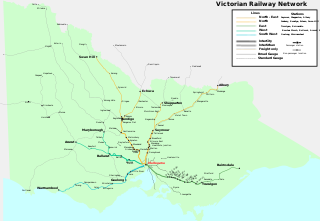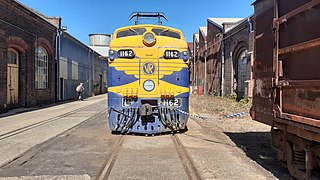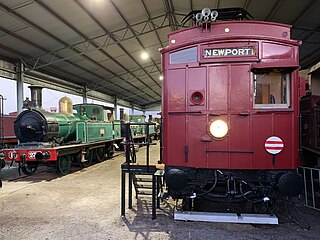
The Newport Railway Workshops is a facility in the Melbourne suburb of Newport, Australia, that builds, maintains and refurbishes railway rollingstock. It is located between the Williamstown and Werribee railway lines.

The Newport Railway Workshops is a facility in the Melbourne suburb of Newport, Australia, that builds, maintains and refurbishes railway rollingstock. It is located between the Williamstown and Werribee railway lines.
Plans for a workshop at Newport started in the 1860s, to replace the temporary Williamstown Workshops but nothing came of it. It was not until 1880 that work began, when the Victorian Railways purchased annexes used at the 1880 Melbourne Exhibition and erected one of them at Newport, naming it the Newport Carriage Workshops when it began operation in 1882. [1]
Construction of the permanent workshops commenced in 1884, and was completed in 1889. [2] Although the earlier carriage workshop closed at this time, it reopened in 1895 to manufacture signal equipment. The first carriages built by the workshops were completed in 1889, but early locomotives were manufactured by external contractors such as the Phoenix Foundry in Ballarat. The first locomotive built in house at Newport was Z Class 2-4-0T No.526 'Polly 'in 1893. [2] The final locomotive built at the workshops was diesel-hydraulic M Class M232 in 1959.
The main elements of the 1889 workshops are a central stores block and clock tower with offices, the 'East Block' for carriage and wagon works, and 'West Block' for heavy engineering and locomotive building. [3] Expansion followed in 1905–1915, and 1925–1930. During World War II the workshops were turned over to military production, with the rear fuselage, and empennage of Bristol Beaufort bombers being built there. [4]
At the peak of operation it was one of Victoria's largest and best-equipped engineering establishments, with up to 5,000 employees on site. [5] The workshops had its own cricket ground, and in the 1920's the game of Trugo is said to have been invented by workers on their lunch hour. [1] In the late 1980's, the original segments of the workshops were removed from everyday use, with operations continuing at the 1930s complex along the eastern side of the site. [6]
On 15 January 2000, ownership of the workshops passed from the Public Transport Corporation to Clyde Engineering. [7]


Current revenue operations are carried out in the eastern section of the workshops by Downer Rail, who carry out work including locomotive and carriage maintenance, and diesel engine, bogie and wheelset overhauls; [8] for customers including Pacific National and V/Line. The site also has the one of 3 broad gauge underfloor wheel lathes in Victoria, the others being at Metro Trains Melbourne's Craigieburn and Pakenham East Depots. From 2018, High Capacity Metro Trains have been constructed at Newport by Evolution Rail. [9] The former Boiler Shop is leased to Metro Trains Melbourne for maintenance of their Siemens Nexas trains.
The original 1880s workshops have been maintained for heritage uses. The 'West Block' area are occupied by a number of railway preservation groups such as Steamrail Victoria, Diesel Electric Rail Motor Preservation Association Victoria and 707 Operations, [10] while the 'East Block' has been retained by VicTrack for the storage of disused trams, buses and rail rollingstock. [3] The Newport Railway Museum is located south of the operating workshops, near North Williamstown railway station. [11]

Rail transport in the Australian state of Victoria is provided by a number of railway operators who operate over the government-owned railway lines. The network consists of 2,357 km of Victorian broad gauge lines, and 1,912 km of standard gauge freight and interstate lines; the latter increasing with gauge conversion of the former. Historically, a few experimental 762 mm gauge lines were built, along with various private logging, mining and industrial railways. The rail network radiates from the state capital, Melbourne, with main interstate links to Sydney and to Adelaide, as well as major lines running to regional centres, upgraded as part of the Regional Fast Rail project.

The Hitachi was an electric multiple unit that operated on the Melbourne suburban railway network between 1972 and 2014. Electrical equipment was supplied by Commonwealth Engineering to designs by Hitachi of Japan, leading to their official name today, though no actual Hitachi-supplied components were used in their construction. They were the last suburban trains in Melbourne with no air conditioning. A total of 355 carriages were built between 1972 and 1981, including a replacement carriage for one written off while the fleet was still being delivered.

The Victorian Goldfields Railway is a 1,600 mm broad gauge tourist railway in Victoria, Australia. It operates along a formerly disused branch line between the towns of Maldon and Castlemaine.
The South Gippsland railway line is a partially closed railway line in Victoria, Australia. It was first opened in 1892, branching from the Orbost line at Dandenong, and extending to Port Albert. Much of it remained open until December 1994. Today, only the section between Dandenong and Cranbourne remains open for use. The section of the line from Nyora to Leongatha was used by the South Gippsland Tourist Railway until it ceased operations in 2016. The section from Nyora to Welshpool, with extension trail to Port Welshpool and a portion of the former line at Koo Wee Rup, have been converted into the Great Southern Rail Trail.

West Coast Railway was a passenger train company operating in Victoria, Australia that operated services between Melbourne and Warrnambool from September 1993 until August 2004. The travel time for the journey was around 3 hours. This is on average around 30 minutes quicker than the current journeys.

The A2 class was an express passenger locomotive that ran on Victorian Railways from 1907 to 1963. A highly successful design entirely the work of Victorian Railways' own design office, its long service life was repeatedly extended as the Great Depression and later World War II delayed the introduction of more modern and powerful replacement locomotives.

The K class was a branch line steam locomotive that ran on Victorian Railways in Australia from 1922 to 1979. Although its design was entirely conventional and its specifications unremarkable, the K class was in practice a remarkably versatile and dependable locomotive. It went on to outlast every other class of steam locomotive in regular service on the VR, and no fewer than 21 examples of the 53 originally built have survived into preservation.

The N class was a branch line steam locomotive that ran on the Victorian Railways (VR) from 1925 to 1966. A development of the successful K class 2-8-0, it was the first VR locomotive class designed for possible conversion from 5 ft 3 in to 4 ft 8+1⁄2 instandard gauge.

The R class was an express passenger steam locomotive that ran on Australia's Victorian Railways (VR) from 1951 to 1974. A long overdue replacement for the 1907-era A2 class 4-6-0, their development and construction was repeatedly delayed due to financial constraints caused by the Great Depression and later the manpower and materials shortages of World War II and the immediate postwar period.

The Victorian Railways J class was a branch line steam locomotive operated by the Victorian Railways (VR) between 1954 and 1972. A development of the successful Victorian Railways K class 2-8-0, it was the last new class of steam locomotive introduced on the VR. Introduced almost concurrently with the diesel-electric locomotives that ultimately superseded them, the locomotives were only in service for a relatively short time.
The DD class (later reclassified into D1, D2 and D3 subclasses) was a passenger and mixed traffic steam locomotive that ran on Victorian Railways from 1902 to 1974. Originally introduced on mainline express passenger services, they were quickly superseded by the much larger A2 class and were relegated to secondary and branch line passenger and goods service, where they gave excellent service for the next fifty years. The DD design was adapted into a 4-6-2T tank locomotive for suburban passenger use, the DDE (later D4) class. They were the most numerous locomotive class on the VR, with a total of 261 DD and 58 locomotives built.

The Victorian Railways L class was a class of electric locomotives built by English Electric and operated by the Victorian Railways and later V/Line from 1953 until 1987 primarily on the Gippsland line. They were the only class of main line electric locomotive operated in Victoria.

The Tait trains were a wooden bodied electric multiple unit (EMU) train that operated on the suburban railway network of Melbourne, Victoria, Australia. They were introduced in 1910 by the Victorian Railways as steam locomotive hauled cars, and converted to electric traction from 1919 when the Melbourne electrification project was underway. The trains derived their name from Sir Thomas James Tait, the chairman of commissioners of the Victorian Railways from 1903 to 1910. The first cars were built during 1909 with the last entering service in 1952.

The A class are a class of diesel locomotives rebuilt from Victorian Railways B class locomotives by Clyde Engineering, Rosewater in South Australia for V/Line in 1984–1985.

The B class are a class of diesel locomotives built by Clyde Engineering, Granville for the Victorian Railways in 1952–1953. Ordered and operated by the Victorian Railways, they initiated the dieselisation of the system and saw use on both passenger and freight services, with many remaining in service today, both in preserved and revenue service. Some were rebuilt as the V/Line A class, while others have been scrapped.

The DRC was a class of railmotor operated by the Victorian Railways on its country rail network in Victoria, Australia. The cars were built by Tulloch Limited in New South Wales, and featured aluminium and steel construction, air-conditioning, and twin diesel engines with hydraulic transmissions.

The Newport Railway Museum is located on Champion Road, Newport, Victoria, near the North Williamstown station.

Steamrail Victoria is a not-for-profit volunteer group established in 1965 to restore and operate historic locomotives and rolling stock used on the railways in Victoria, Australia. The main depot of the group is at the Newport Workshops in suburban Melbourne. In addition to operating railfan special trains and charters for private groups, the group also operates special steam trains in the Melbourne suburban area. Steamrail regularly tours the state, including participation in annual events such as the Ballarat Heritage Weekend. Steamrail Victoria also leases diesel locomotives to freight operators such as Southern Shorthaul Railroad (SSR) & Qube Logistics as required. Locomotives were also hired to El Zorro until they ceased trading.
Bendigo Workshops is a railway workshop in Bendigo, Victoria, Australia. It is located in the north of the city beside the junction of the Yungera and Deniliquin railway lines. The site covers 10.3 hectares of land and has 31 separate buildings, including a 10,000 sqm main workshop building and six kilometres of railway track.

Between 1936 and 1942, South Australian Railways built 36 steel carriages at its Islington Railway Workshops. All were painted cream and green being repainted maroon and silver in the 1960s. Aside from a few written off after accidents, all passed to Australian National in March 1978.
![]() Media related to Newport Workshops at Wikimedia Commons
Media related to Newport Workshops at Wikimedia Commons